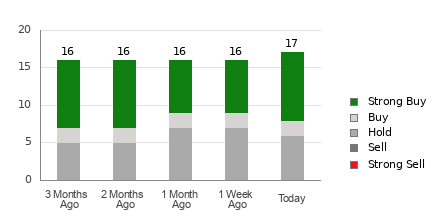When deciding whether you want to buy, sell or keep a share, trust investors often on recommendations from analysts. Media reports on assessment changes by these brokerage-firm-unemployed (or sales) analysts often influence the price of a share, but are they really important?
Before we discuss the reliability of broker recommendations and how they can be used to your advantage, let’s see where these heavy weights from Wall Street think about Barrick Gold ((GOLD – Free report).
Barrick Gold currently has an average brokerage recommendation (ABR) of 1.82, on a scale of 1 to 5 (strong purchase to strong sales), calculated on the basis of the actual recommendations (buying, hold, sell, etc.) by 17 brokerage companies. An ABR of 1.82 approaches between buying and buying strong.
Of the 17 recommendations that distract the current ABR, nine are a strong purchase and two are buying. Buying and buying strong is good for 52.9% and 11.8% of all recommendations respectively.
Brokerage recommendation trends for gold

Check the price target and stock forecast for Barrick Gold here >>>
Although the ABR calls on buying Barrick Gold, it may not be wise to make an investment decision exclusively based on this information. Various studies are limited to no success of Brokerage recommendations in supervising investors to choose shares with the best potential for price increase.
Do you wonder why? The established interest of brokerage companies in a share that they cover often results in a strong positive bias of their analysts in assessing them. Our research shows that for every recommendation “strong sales”, brokerage companies assign five “strong buy” recommendations.
This means that the interests of these institutions are not always tailored to those of retail investors, which gives little insight into the future price movement of a share. It would therefore be best to use this information to validate your own analysis or a tool that has proved to be very effective when predicting share price movements.
Zacks Rank, our own stock assessment tool with an impressively externally controlled track record, categorizes shares in five groups, ranging from Zacks Rank #1 (Strong Buy) to Zacks Rank #5 (Strong Sell), and is an effective indicator for the price performance of a share in the near future. That is why the use of the ABR to validate the Zacks rang can be an efficient way to make a profitable investment decision.
ABR should not be confused with Zacks Rank
Despite the fact that Zacks Rank and ABR both appear on a scale of 1 to 5, they are two completely different measures.
Broker recommendations are the only basis for calculating the ABR, which is usually displayed in decimals (such as 1.28). The Zacks rang, on the other hand, is a quantitative model that is designed to use the power of Winstrevisies. It is displayed in whole numbers – 1 to 5.
Analysts in the service of brokerage companies are and remain overly optimistic with their recommendations. Since the assessments of these analysts are more favorable than their research would support because of the established interest of their employers, they mislead investors much more often than they guide.
On the other hand, the estimate of the profit is the core of the Zacks ranking. And empirical research shows a strong correlation between trends in Winstrevisions and in the short term share price movements.
In addition, the different figures of the Zacks -Rang are relatively applied to all shares for which brokerage analysts offer profit estimates for the current year. In other words, at all times this tool maintains a balance between the five ranks that it assigns.
There is also an important difference between the ABR and Zacks rang when it comes to freshness. If you look at the ABR, it may not be up-to-date. Since brokerage analysts are constantly revising their profit estimates to display changing business trends, and their actions are reflected in the Zacks ranges quickly enough, it is always timely in predicting future stock prices.
Do you have to invest in gold?
Looking at the Winstraming Reviews for Barrick Gold, the estimate of the Zacks consensus for the current year has fallen by 3.4% to $ 1.47 in the past month.
The growing pessimism of analysts on the company’s profit perspectives, as indicated by a strong agreement among them when revising EPS estimates lower, could be a legitimate reason for the shares to fall in the short term.
The size of the recent change in the consensus estimate, together with three other factors with regard to profit estimates, has resulted in a Zacks rank #5 (strong sales) for Barrick Gold. You can see the full list of the Rank #1 (strong purchase) shares of today >>>>>
That is why it may be wise to take the buy equivalent ABR for Barrick Gold with a grain of salt.


